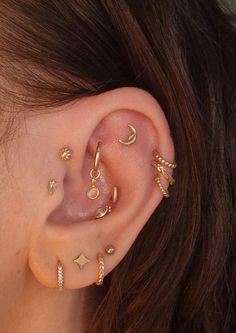Ear piercings are a popular way to express personal style, but proper aftercare is essential to ensure they heal correctly and avoid complications. Mistakes in piercing care can lead to infections, irritation, or even permanent damage. Here’s a guide to common Ear Piercing in Dubai, care mistakes and how to avoid them.
1. Ignoring Aftercare Instructions
One of the most significant mistakes people make after getting their ears pierced is not following the aftercare instructions provided by their piercer. These instructions are crucial for preventing infection and ensuring proper healing.
What to Do: Always adhere to the care guidelines given by your piercer, which typically include cleaning the piercing with a saline solution and avoiding touching or twisting the earring.
2. Using the Wrong Cleaning Products
Using harsh cleaning agents like hydrogen peroxide or alcohol can damage the skin and delay healing. These substances can dry out the piercing and disrupt the natural healing process.
What to Do: Use only the saline solution or mild, non-alcoholic cleaning products recommended by your piercer. Avoid using alcohol, hydrogen peroxide, or other strong antiseptics.
3. Touching or Twisting the Piercing
Many people instinctively touch or twist their new piercings, but this can introduce bacteria and cause irritation. Frequent touching or twisting can also lead to complications like keloids or hypertrophic scars.
What to Do: Resist the urge to touch or twist your earrings. Clean your hands thoroughly before touching your piercing, and only handle it when necessary for cleaning.
4. Sleeping on the Pierced Ear
Sleeping on a new piercing can cause pressure and friction, leading to irritation and prolonging the healing process. It can also increase the risk of infections.
What to Do: Try to sleep on your back or on the opposite side of your pierced ear. Using a travel pillow or a specialized pillow with a hole can help avoid pressure on the piercing.
5. Changing Earrings Too Soon
Changing earrings too early can disrupt the healing process and increase the risk of infection. It’s essential to let the initial piercing heal completely before changing the jewelry.
What to Do: Keep the original earrings in place for the duration recommended by your piercer, usually 6-8 weeks for earlobe piercings. Consult with your piercer before changing the jewelry.
6. Wearing Earrings Made of Low-Quality Materials
Wearing earrings made of low-quality or non-hypoallergenic materials can irritate the piercing and cause allergic reactions. This can lead to complications and hinder the healing process.
What to Do: Opt for earrings made of high-quality, hypoallergenic materials such as surgical steel, titanium, or gold. Avoid earrings with nickel or other irritants.
7. Not Keeping the Piercing Dry
Moist environments can promote bacterial growth and increase the risk of infection. Keeping the piercing too wet or exposing it to excessive moisture can cause problems.
What to Do: Keep the piercing clean and dry. Avoid swimming pools, hot tubs, and excessive sweating until the piercing is fully healed. Gently pat the area dry with a clean, soft cloth after cleaning.
8. Using Public Facilities Without Proper Care
Using public facilities like swimming pools or gyms without proper care can expose your new piercing to bacteria and increase the risk of infection.
What to Do: Avoid public swimming pools, hot tubs, and saunas until your piercing is fully healed. If you must use these facilities, ensure your piercing is properly protected and clean it thoroughly afterward.
9. Over-Cleaning the Piercing
Cleaning the piercing too frequently or using excessive amounts of cleaning solution can irritate the area and delay healing. Over-cleaning can disrupt the natural healing process and lead to dryness.
What to Do: Follow the cleaning instructions provided by your piercer and clean the piercing no more than twice a day. Avoid overusing cleaning solutions.
10. Ignoring Early Signs of Infection
Ignoring symptoms like redness, swelling, pain, or discharge can lead to more severe complications. Early intervention is crucial for preventing infections from worsening.
What to Do: Monitor your piercing for any signs of infection. If you notice symptoms such as increased pain, pus, or a fever, consult your piercer or a healthcare professional immediately.
Conclusion
Taking care of new ear piercings requires attention to detail and adherence to proper aftercare practices. Avoiding these common mistakes will help ensure that your piercings heal correctly and remain free of complications. By following the recommended care instructions and being mindful of potential pitfalls, you can enjoy your new piercings with minimal hassle and maximum comfort.





Comments